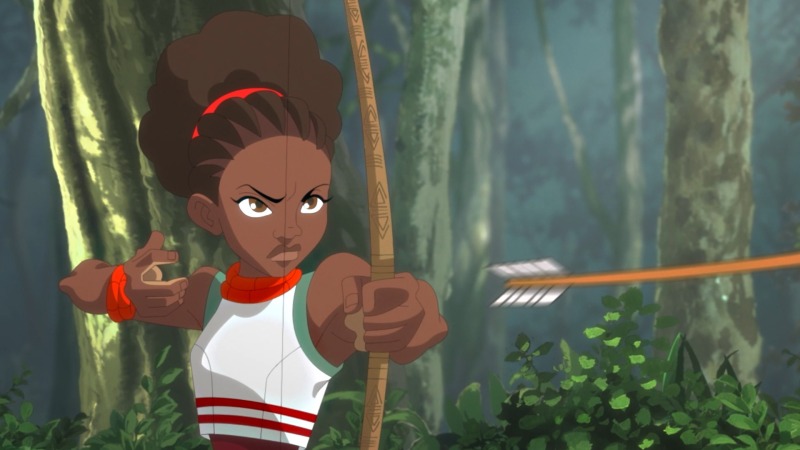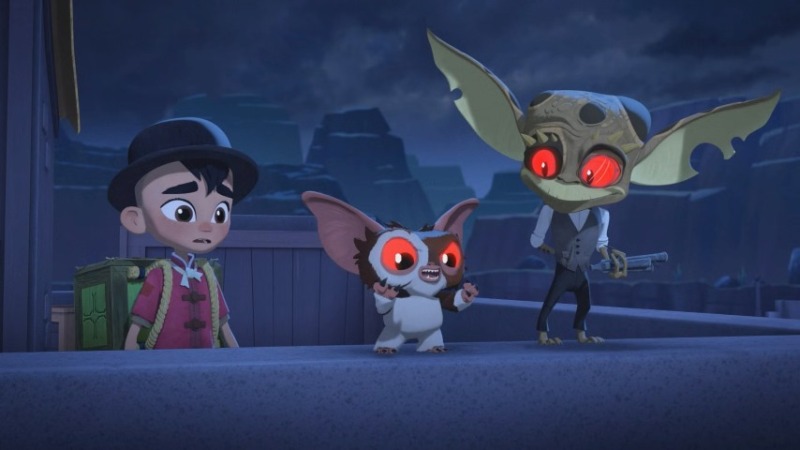Toon In: Animated TV Highlights for April, from Devil May Cry to Iyanu

Welcome to the ink, paint, and pixel corner of Paste TV, where we’re highlighting some of the best premium animation projects on streaming or direct-to-video aimed for teens and adults. This monthly column not only provides an overview of the new animated series to check out, but we’ve also collected some of the finest creators and voice talents in the medium to give updates, or introductions, to their series.
Devil May Cry Post Mortem (Premiered April 3)
Almost 25 years since Capcom debuted the Devil May Cry videogame series centered on an incredibly powerful demon hunter named Dante, the franchise is finally getting its own adult animated series on Netflix. The latest game-to-animated series adaptation from Adi Shankar (Castlevania) for Netflix, Devil May Cry is an engrossing (and gory) reimagining of the canon that pulls from all areas of the mythology.
However, Shankar is quick to clarify to Paste that Devil May Cry is not part of his Adi Shankar Animation “bootleg universe” wing of storytelling. “That is when I deeply subvert things, rearrange it and make it something new, or point out some sort of new lens through the IP,” he explains. “This show is not that.”
Shankar says he’s been a dedicated fan of the DMC gameverse since the original came out in 2001, and that expanded his interests into the manga, the 2007 anime series and every iteration of the game. “My biggest issue with Devil May Cry was just that I didn’t feel like there was enough of it and I wanted to actually do Devil May Cry. So, this is a ‘by-a-fan-for fans’ adaptation of the intellectual property from Capcom.”
Shankar’s series places Dante (voiced by Johnny Yong Bosch), Mary/Lady (Scout Taylor-Compton) and the White Rabbit (Hoon Lee) as the central characters of the narrative. Set in contemporary times, the three eventually come together when a violent break in and burglary of the Vatican tips off a demon’s plan to open a portal to Hell that will allow the two planes of existence to merge.
Pulling from all corners of the universe to set up this story, Shankar says this show was an opportunity to appeal to hard core fans like him, and also appeal to new viewers. “It was an opportunity to really take the entire media franchise, known as Devil May Cry, and arrange it into a coherent timeline.”
While the details may be different, Shankar says existing fans will easily recognize the beloved characters. “I was personally very drawn to the characters and I had to preserve the characters. While the tone changes, the setting, the costumes, the lighting, package, the music shifts with every game, the characters, for the most part, do tend to stay the same.
“The one deviation I did make from the game, and this was a choice, was to set it in the real world,” he continues. “The games exist in the game world and here I made the choice, inspired by the Christopher Nolan Batman movies,” which he says was his benchmark example for how to reimagine classic characters. “My show is the most ungrounded possible thing, but I set it in the real world and that gives it a tinge of grounding that will bring it down to reality, even though Dante is essentially Superman.”
[Spoilers below!] The first season establishes the demon vs. human world, a strong ensemble of characters and introduces fight sequences well-influenced by game combat. Devil May Cry also creates great stakes around its core trio, the White Rabbit, Dante and Lady.
“They are all born of tragedy and that was a discovery that happened in draft 10 of the outline,” Shankar says. “They all lost their family, so it was a core tenant of the brand. But it was also a discovery thing that was happening during the outlining and the scripting phase.”
Shankar says this younger Dante is still learning who is worth trusting or not. “One of the things that’s so beautiful about the character of Dante is we have this whole universe where everyone’s just dealing with so much loss but he finds a way to let it not destroy him. It’s the beauty of this character. He finds a way to not let the loss completely destroy him, or completely define him.”
And Mary represents someone who has to come to understand that a black and white view of the world isn’t going to make her killing mission any easier. “These characters now have to make choices,” he says of where the season finale leaves them in “A River of Blood and Fire.” “Just like in real life, when you level up, you reach forks in the road. People who are deeply ungrounded because they lost a parent figure and are trying to regain that through other means. The thing about Mary is — and this is from the games — she’s super anti-demons. They’re all evil. The game makes it clear in the lore, also the mangas make it clear and in Episode 3 of the original 2007 anime, they all make it clear that not all demons are bad. And now we are now going to make you challenge your beliefs,” he says of Mary’s formerly trusted superior, VP Baines (Kevin Conroy), who enters Hell to bring it to its knees.
With the passing of Conroy in 2022, Shankar is thrilled they got to feature one of his last performances. “Kevin gave a deeply nuanced performance. You know, he originally came in for the White Rabbit,” he shares. “Netflix sent me the auditions and I was like, ‘Kevin Conroy auditioned!’ I would think I’d have to trek to a mountain…to even have the opportunity for him. So, I was like, ‘We have to give him White Rabbit.’ But then you listen to it and you’re like, ‘This doesn’t like work at all,’ because he’s too seasoned. The White Rabbit is a little little more maniacal. But literally, five seconds into the audition, I’m like, ‘That’s Baines. That is Baines mocking the White Rabbit.’”
Jurassic World Chaos Theory Post Mortem (Premiered April 3)
[Spoilers Below!] If you’ve watched the ongoing saga of the “Nublar Six” on Netflix, going back to Camp Cretaceous and now continuing with Jurassic World: Chaos Theory, then you know that both series have always existed within the canon of the Jurassic World films. While there’s been a generous use of some shared locales, props, and certainly dinosaur species, Season 3 of Jurassic World: Chaos Theory does something the animated series has never done before – merge their story into actual scenes from Jurassic World Dominion.
Scott Kreamer, the co-showrunner/executive producer of Jurassic World: Chaos Theory, tells Paste, “I guess this was sort of our blockbuster season.” Taking place in Senegal, Italy and Malta, not only is the globetrotting amped up, but three important characters from the films are featured: Barry Sembène (voiced by Evan Michael Lee), Lewis Dodgson (Adam Harrington) and Soyona Santos / The Broker (voiced by Dichen Lachman).
“All I can tell you is, there’s a lot of communication to pull off,” Kreamer chuckles about backwards engineering this season to integrate Brooklynn (Kiersten Kelly) and Santos’ silent Atrociraptor trainer, The Handler, into the happenings at Malta.
“We’ve all worked on shows where the writers are writing stuff that is unachievable, and the board artists are drawing stuff that we don’t have,” Kreamer says of how ambition often gets axed for budget or time on animated series. “But about midway through Season 1, we started these things called ‘do-ability’ meetings, so we’re not writing and drawing stuff we can’t do. We took that to a whole new level on this show, where we had meetings after premise, after every draft. We all had to be in sync. Bethany Armstrong Johnson, our head writer, really kept the coordination going with the production department, the story department, the writing, the design, even lighting. Everybody in every department always answered the call, And everyone always took ownership over what they’re doing. For something this unwieldy on a TV animation schedule and budget, it’s all credit to the team.”
In “No Escape” and “Active Pursuit,” the writers literally place Brooklynn and The Handler in the back of the truck that Santos stands in front of in the film when she’s surrounded by Barry and Owen.
“We pressure test everything, and we’re like, ‘Okay, could The Handler and Brooklyn be in the back of that truck?” Kreamer says about how they worked through Dominion’s potential joining points. “And we said, ‘You know, they could.’ We cut away after Barry’s guys tell Santos to put her hands up. We don’t see her again [in the film], so that gave us a lot of room to play with. It’s tricky but it’s part of the whole puzzle of telling these stories by telling our own story, enhancing what’s in the movie, but not breaking the reality of what’s going on in the movie.”
A different kind of surprise this season was hearing Beatrice Grannò (The White Lotus) voice Gia, Ben’s girlfriend in Italy, and Isabella Rossalini (Conclave) as her Nonna. “We were talking about an Italian grandmother and I said that I want no subtitles and I just want the performance,” Kreamer says of their early cast conversations. “Then Bethany goes, ‘What about Isabella Rossellini?’ I said, ‘We’re obviously not going to get Isabella Rossellini, but let’s run it by the team.’ And you know what…we got Isabella Rossellini. It’s crazy! She was so delightful. It’s definitely a career highlight.”
In a season full of high notes, the climactic face-off in the finale, “Morituri Te Salutant,” amongst Santos, The Handler, Brooklynn, a Carnotaurus and the pack of Atrociraptors was one of the show’s best moments in how it closed the arc of The Handler…with a brutal chomp.
“Ideally, I would have shown a little more, but technically, it’s a kid show,” Kreamer admits of the Carnotaurus eating her whole. “We had a scene where you saw the leg and more blood on the whistle, and they said you can’t do any of that. Hopefully, people get it. I can’t remember exactly when that idea came to us, but as we’re heading deeper and deeper into Dominion, and there’s no Handler…. And I just love the idea that that’s the only time you hear her speak in this series.”
The season ends with Brooklynn, Ben, Darius and Yaz on the Biosyn drone copter heading towards Dodgson’s Biosyn Valley, while Kenji and Sammy head towards the same place via land. Kreamer says, “We always wanted them to come back together. But just because they’re back together; this isn’t one of those shows where it’s like, ‘Welp, we’re all back together and everything is alright!’ We definitely want it to feel messy and real and complicated, like people really are. So, if we get to do more, I wouldn’t say it’s going to be easy. We had a lot of plates spinning and a lot of balls in the air for this one, so we’ll just have to see what the future holds.”
-

-

-

-

-

-

-

-

-

-

-

-

-

-

-

-

-

-

-

-

-

-

-

-

-

-

-

-

-

-

-

-

-

-

-

-

-

-

-

-









































